#violence in brazil
Text
ScuderiaFerrari: "I don't like this game, it's so unfair." 😂
#im deeeaddd#he slapped charles' chest so aggressively#carlos' love language = violence#charles leclerc#carlos sainz#charlos#c2 challenge#video#Brazil GP '23#2023
516 notes
·
View notes
Text
Today is the 60th anniversary of the Military Coup that occurred here in Brazil (with a little help from USA, may I remind you)
The military killed and tortured thousands of people. They killed mothers, fathers, brothers, sisters, daughters, sons, friends… they tortured children. They faked suicides. They targeted trans people, specially trans woman. They massacred indigenous.

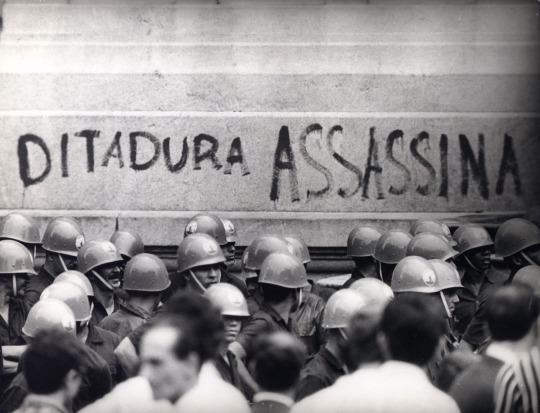




Always good to remember the face of those who were assassinated by the dictatorship fighting for our freedom. Remember their names. Remember their faces. Don’t let their death be in vain.

Telma Regina Cordeiro Correa: a geography student from my university. Now the academic directory (it’s like the college version of a student council in Brazil) of Geography has her name.

Stuart and Zuzu Angel: Stuart was an activist fighting for the end of the dictatorship. He went missing and his mother. The stylist Zuzu Angel started to talk about the dictatorship with foreign media. She was killed by a car “accident”.

Edson Luís: a highschooler killed by the militaries during a protest against the high prices of the school’s restaurant.

Alfeu de Alcântara Monteiro: A military from the Aeronautical He was killed by their own colleagues for standing up for democracy, being considered the first victim of the dictatorship.
And there are many, MANY more. Some of them were actively fighting against the militaries (sometimes literally, with guns and etc). Others were just mistaken. Some were just “wrong place, wrong time” situations. Others helped someone who was fighting. But their lives ended unfairly. Some families couldn’t even bury their loved ones. And that’s why we need to remember.
“Ódio e nojo à Ditadura! Para que não se esqueça, para que nunca mais aconteça: DITADURA NUNCA MAIS!” (EN, loosely translated: Spite and pish towards dictatorship! So we never forget, so it never happens again: DICTATORSHIP NEVER MORE!)
#brazil#brasil#today in history#history#ditadura#brazilian history#brazilian culture#TEMOS ÓDIO E NOJO! ÓDIO E NOJO A DITADURA!#tw: violence#tw: death mention#tw: torture mention#in memoriam
114 notes
·
View notes
Text
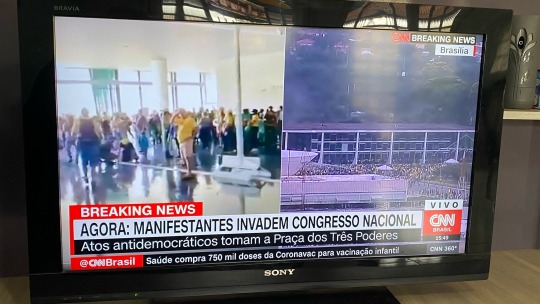
The former president's supporters invaded our National Congress and causing chaos and depredation after the former extreme right president lost the elections and left Brazil to hide in the U.S. the act is clearly inspired in the capitol's invasion after Biden won. Many of them came to the capital of Brazil, Brasilia, in November, set fire to buses, cars, have been camping outside army headquarters asking for the army to take over power in a military coup.
Those supporters also planned to blow a bomb at the international airport, going so a far as to set it but the police intervened. They came over in caravans last night planning on attacking the city today, the national congress being public patrimony that is representative of the democratic power in Brazil, and those people are trying to incite o violent coup. The local government of Brasilia is already being accused of not taking enough measures to keep those violent anti democratic protesters out of the area. So far, it seems there is no police there yet, the cavalry seems to be on their way.
Please don't support these people claiming the elections were fraudulent. We have one of the best electoral systems in the world to avoid fraud. The ex president was from the extreme right, defended torture during our past military dictatorship and was in favor of said dictatorship. He is already being accused of one of the biggest corruption scandals in the history of the country. He lost the elections fairly because of his extremism, corruption and incompetence as president.
Also remember the former president has left the country and all his supporters to hide in the US. As said, he is already being accused of several corruption crimes, including regarding the pocketing the money that should go towards buying of covid vaccines and letting 700k people die while the health system collapsed.
Translation of the cnn headlines: "just now: protesters invade the national congress".
For now I can't find sources in English because this just happened now at the beginning of the afternoon of this Sunday, January 8th, but as soon as there are, I'll post them.
#tw violence#tw political coup#tw covid#tw death#tw fascism#tw genocide mention#tw política#tw bomb#Brazil#Brasilia
2K notes
·
View notes
Text
Brazil tbt
They got skills
#the ‘ay ay ay’ and Carlos resorts to violence again#carlos sainz jr#charles leclerc#scuderia ferrari#c2#c square#charlos#f1#the amount of times Carlos lost focus and went off to do his own thing with the ball at the side in this video#brazil 2022
79 notes
·
View notes
Text
🇧🇷🇵🇸 🚨
PROTESTERS RALLY FOR GAZA ON INTERNATIONAL AL-QUDS DAY IN BRAZIL
📹 Scenes from Sao Paulo, Brazil where protesters rallied today on International Al-Quds Day to demand a ceasefire in Gaza and to stand in solidarity with Palestine.
#source
@WorkerSolidarityNews
#gaza#sao paulo#brazil#brazil news#gaza strip#palestine#palestine news#palestinians#ceasefire#palestine protest#pro palestine protest#protest#israel#israeli occupation#israeli violence#occupation#apartheid#gaza genocide#genocide in gaza#genocide of palestinians#politics#news#geopolitics#world news#global news#international news#war#breaking news#current events#war in gaza
33 notes
·
View notes
Text
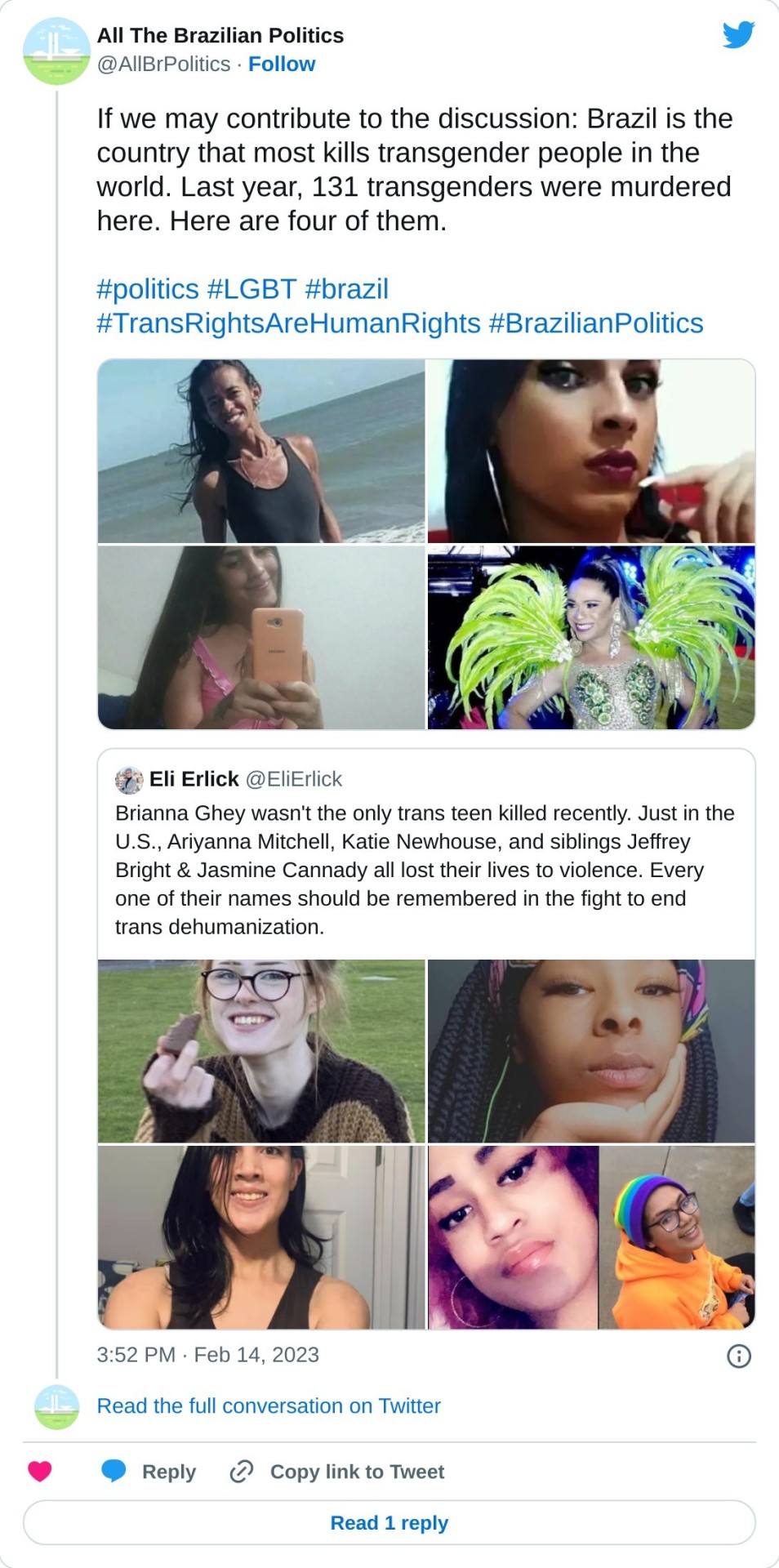
#brazil#politics#LGBT#brazilian politics#brianna ghey#public security#mod nise da silveira#image description in alt#originals#expand the thread for info on the victims and outlooks on the situation of violence against transgenders here
305 notes
·
View notes
Text
girl my country is in the hands of fascists. actual moustache-twirling fascists. 700k dead in their belts fascists. GENOCIDAL FASCISTS. i don’t know how else to stress how desperately sad and tragic it is to be brazilian tonight. they won. they actually fucking won again. i mean. lula had the majority of votes, it was like over a 5 million difference, so there will be a second round for presidents, but they still won PRETTY MUCH EVERYTHING ELSE. please please pay attention to what’s going on in brazil for the next 28 days. we’re desperate. we’re dying. people are being brutally murdered because of bolsonaro’s fanatics. there are people who have been stabbed to death for over 70 times. a pregnant woman was assaulted and beaten in the middle of the fucking STREETS. it’s so ugly already and it’s only gonna get worse for us. please pray for brazil yall.
#current events#brazil#elections#brazilian elections#murder tw#violence against women tw#genocide tw#fascism tw#violence tw#political violence tw#politics
770 notes
·
View notes
Text
Éverton Guandeli, a black delivery man, was attacked by an old, white man and called for help. Police arrived and arrested him instead, and the aggressor stayed silent. He was taken to the police hours later.
This happened in my state just a few days ago, and our governor keeps saying how he trusts our racist police force. Vile
#sam.message#blm#black lives matter#brazil#latam#latin america#abya yala#south america#rio grande do sul#racism tw#racism#police tw#police#police brutality tw#police brutality#violence tw#violence
25 notes
·
View notes
Text

𝔄𝔫𝔞𝔯𝔨𝔥𝔬𝔫
#Anarkhon#Genre: Brutal Death Metal#yrical themes: Gore Sex Violence Murder (early); Lovecraftian Cosmic horror#Country of origin: Brazil#Location: Guarulhos São Paulo#Péricles Hooper (R.I.P. 2006)
16 notes
·
View notes
Text
Sometimes I think about the angry bunny who attacks people and dates a chicken

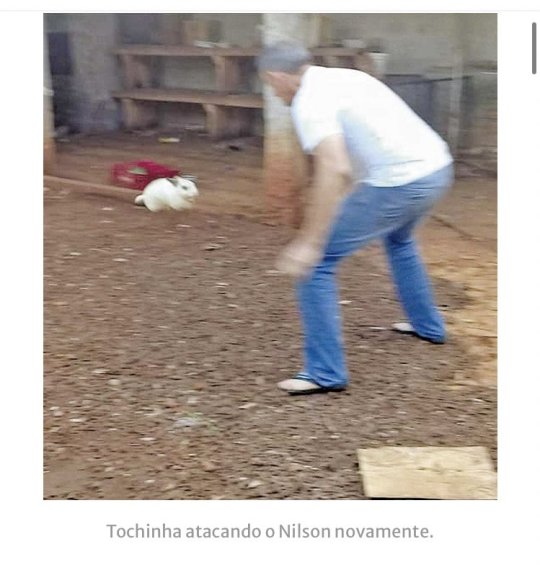

#animals#rabbit#bunny#chicken#relationship goals#brazil#violence is not the answer- it's a question and the answer is always yes
94 notes
·
View notes
Text
How the world’s favorite conservation model was built on colonial violence | Grist
On a 1919 trip to the United States, King Albert I of Belgium visited three of the country’s national parks: Yellowstone, Yosemite, and the newly established Grand Canyon. The parks represented a model developed by the U.S. of creating protected national parks, where visitors and scientists could come to admire spectacular, unchanging natural beauty and wildlife. Impressed by the parks, King Albert created his own just a few years later: Albert National Park in the Belgian Congo, established in 1925.
Widely seen as the first national park in Africa, Albert National Park (now called Virunga National Park), was designed to be a place for scientific exploration and discovery, particularly around mountain gorillas. It also set the tone for decades of colonial protected parks in Africa. Although Belgian authorities claimed that the park was home to only a small group of Indigenous people — “300 or so, whom we like to preserve” — they violently expelled thousands of other Indigenous people from the area. The few hundred selected to remain in the park were seen as a valuable addition to the park’s wildlife rather than as actual people.
And so modern conservation in Africa began by separating nature from the people who lived in it. Since then, as the model has spread across the globe, inhabited protected areas have routinely led to the eviction of Indigenous peoples. Today, these conservation projects are led not by colonial governments but by nonprofit executives, large corporations, academics, and world leaders.
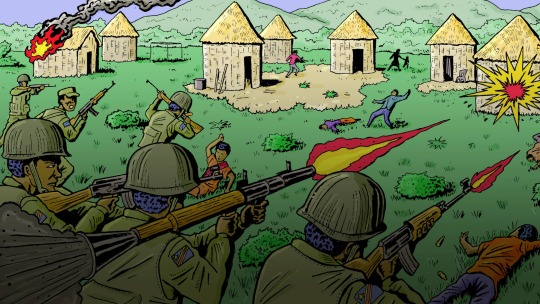
For much of human history, most people lived in rural areas, surrounded by nature and farmland. That all changed with the Industrial Revolution. By the end of the 19th century, European forests were vanishing, cities were growing, and Europeans felt increasingly disconnected from the natural world.
“With industrialization, the link with the natural cycle of things got lost — and that also led to a certain type of romanticization of nature, and a longing for a particular type of nature,” said Bram Büscher, a sociologist at Wageningen University in the Netherlands.
In Africa, Europeans could experience that pure, untouched nature, even if it meant expelling the people living on it.
“The idea that land is best preserved when it’s protected away from humans is an imperialist ideology that has been imposed on Africans and other Indigenous people,” said Aby Sène-Harper, an environmental social scientist at Clemson University in South Carolina.
For Europeans, creating protected parks in Africa allowed them to expand their dominion over the continent and quench their thirst for “undisturbed” nature, all without threatening their ongoing expansion of industrialization and capitalism in their own countries. With each new national park came more evictions of Indigenous people, paving the way for trophy hunting, resource extraction, and anything else they wanted to do.

In the mid-19th century, European colonization of Africa was limited, largely confined to coastal regions. But by 1925, when King Albert created his park, Europeans controlled roughly 90 percent of the continent.
At the time, these parks were playgrounds for wealthy Europeans and part of a massive imperial campaign to control African land and resources. Today, there are thousands of protected national parks around the world covering millions of acres, ranging from small enclosures like Gateway Arch National Park in St. Louis to sprawling landmarks like Death Valley in California and Kruger National Park in South Africa. And the world wants more.
Scientists, politicians, and conservationists are championing the protected-areas model, developed in the U.S. and perfected in Africa. In late 2022, at the United Nations Biodiversity Conference in Montreal, nearly 200 countries signed an international pledge to protect 30 percent of the world’s land and waters by 2030, an effort known as 30×30 that would amount to the greatest expansion of protected areas in history.
So how did protected parks move from an imperial tool to an international solution for accelerating climate and biodiversity crises?
In the early part of the 20th century, the expansion of colonial conservation areas was humming along. From South Africa to Kenya and India, colonial governments were creating protected national parks. These parks provided a host of benefits to their creators. There were economic benefits, including extraction of resources on park land and tourism income from increasingly popular safaris and hunting expeditions. But most of all, the rapidly developing network of parks was a form of control.
“If you can sweep a lot of peasants and Indigenous peoples away from the lands, then it’s easier to colonize the land,” Büscher said.
This approach was enshrined by the 1933 International Conference for the Protection of the Fauna and Flora of Africa, which created one of the first international treaties, known as the London Convention, to protect wildlife. The convention was led by prominent trophy hunters, but it recommended that colonies restrict traditional African hunting practices.
“Conservation is an ideology. And this ideology is based on the idea that other human beings’ ways of life are wrong and are harming nature, that nature needs no human beings in order to be saved,” said Fiore Longo, a researcher and campaigner at Survival international, a nonprofit that advocates for Indigenous rights globally.
The London Convention also suggested national parks as a primary solution to preserve nature in Africa — and as many African countries saw the creation of their first national parks in the first half of the 20th century, the removal of Indigenous peoples continued. The convention was also an early sign that conservation was becoming a global task, rather than a collection of individual projects and parks.
This sense of collective responsibility only grew in the aftermath of World War II, when many international organizations and mechanisms, like the United Nations, were created, ushering in a new period of global cooperation. In 1948, the International Union for Conservation of Nature, or IUCN, the world’s first international organization devoted to nature conservation, was established. This would help pave the way for a new phase of international conservation trends.
By the middle of the 20th century, many countries in Africa were beginning to decolonize, becoming independent from the European powers that had controlled them for decades. Even as they lost their colonies, the imperial powers were not willing to let go of their protected parks. But at the same time, the IUCN was proving ineffective and underfunded. So in 1961, the World Wildlife Fund, or WWF, an international nonprofit, was founded by European conservationists to help fund global efforts to protect wildlife.
Sène-Harper said that although the newly independent African countries nominally controlled their national parks, many of them were run or supported by Western nonprofits like WWF.
“They’re trying to find more crafty ways to be able to extract without seeming so colonial about it, but it’s still an imperialist form of invasion,” she said.
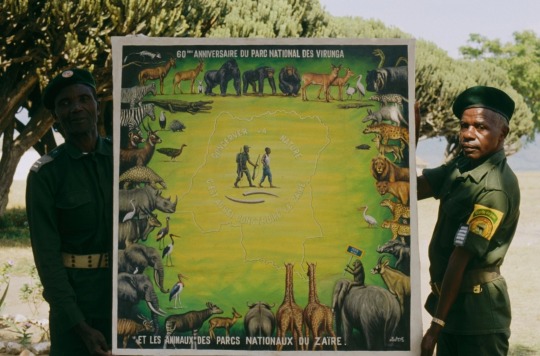
Although these nonprofits have done important work in raising awareness of the extinction crisis, and have had some successes, experts say that the model of colonial conservation has not changed and has only made the problem worse.
Over the years, WWF and other nonprofits have helped fund violent campaigns against Indigenous peoples, from Nepal to the Democratic Republic of the Congo. And amid it all, climate change continues to worsen and species continue to suffer.
In 2019, in response to allegations about murders and other human rights abuses, WWF conducted an independent review that found “no evidence that WWF staff directed, participated in, or encouraged any abuses.” The organization also said in a statement that “We feel deep and unreserved sorrow for those who have suffered. We are determined to do more to make communities’ voices heard, to have their rights respected, and to consistently advocate for governments to uphold their human rights obligations.”
“I think most of [the big NGOs] have become part of the problem rather than the solution, unfortunately,” Büscher said. “The extinction crisis is very real and urgent. But, nonetheless, the history of these organizations and their policies are incredibly contradictory.”
To Indigenous people who had already suffered from decades of colonial conservation policies, little changed with decolonization.
“When we got independence, we kept on the same policies and regulations,” said Mathew Bukhi Mabele, a conservation social scientist at the University of Dodoma in central Tanzania.
In 1992, representatives from around the world gathered in Rio De Janeiro for the United Nations Conference on Environment and Development. The Earth Summit, as it has come to be known, led to the creation of the United Nations Framework Convention on Climate Change as well as the Convention on Biological Diversity, two international treaties that committed to tackling climate change, biodiversity, and sustainable development.
Biodiversity is the umbrella term for all forms of life on Earth including plants, animals, bacteria, and fungi.
Although the Earth Summit was a pivotal moment in the global fight to protect the environment, some have criticized the decision to split climate change and biodiversity into separate conferences.
“It doesn’t make sense, actually, to separate out the two because when you get to the ground, these are going to be the same activities, the same approaches, the same programs, the same life plans for Indigenous people,” said Jennifer Tauli Corpuz, who is Kankana-ey Igorot from the Northern Philippines and one of the lead negotiators of the International Indigenous Forum on Biodiversity.
From left: The 1992 UN Conference on Environment and Development, also known as the Earth Summit, brought together political leaders, diplomats, scientists, representatives of the media, and non-governmental organizations from 179 countries. Indigenous environmentalist Raoni Metuktire, a chief of the Kayapo people in Brazil, talks with an Earth Summit attendee.
In the years following the Earth Summit, biodiversity efforts began to lag behind climate action, Corpuz said.
Protecting animals was trendy during the early days of WWF, when images of pandas and elephants were key fundraising tactics. But as the impacts of climate change intensified, including more devastating storms, higher sea levels, and rising temperatures, biodiversity was struggling to gain as much attention.
“There were 100 times more resources being poured into climate change. It was more sexy, more charismatic, as an issue,” Corpuz said. “And now biodiversity wants a piece of the pie.”
But to get that, proponents of biodiversity needed to develop initiatives similar to the big goals coming out of climate conferences. For many conservation groups and scientists, the obvious solution was to fall back on what they had always done: create protected areas.
This time, however, they needed a global plan, so scientists were trying to calculate how much of the world they needed to protect. In 2010, nations set a goal of conserving 17 percent of the world’s land by 2020. Some scientists have supported protecting half the earth. Meanwhile, Indigenous groups have proposed protecting 80 percent of the Amazon by 2025.
How the world arrived at the 30×30 conservation model
Explore key moments in conservation’s global legacy, from the United States’ first national park in the 19th century to the expansion of colonial conservation areas in the early 20th century and the current push to protect 30 percent of the world’s land and oceans by 2030.
1872: Yellowstone becomes the first national park in the U.S.
1919: King Albert I of Belgium tours Yellowstone, Yosemite, and the Grand Canyon
1925: Albert National Park is established in the Belgian Congo
1933: One of the first international treaties to protect wildlife, known as the London Convention, is created by European conservationists
1948: The International Union for Conservation of Nature (IUCN) is established
1961: The World Wildlife Fund, a non-governmental organization, is founded by European conservationist
1992: The Earth Summit in Brazil creates the Convention on Biological Diversity (CBD)
2010: CBD sets a goal of conserving 17% of the world’s land by 2020
2022: At the UN Biodiversity Conference, nearly 200 countries set 30×30 as an international goal
In 2019, Eric Dinerstein, formerly the chief scientist at WWF, and others wrote the Global Deal for Nature, a paper that proposed formally protecting 30 percent of the world by 2030 and 50 percent by 2050, calling it a “companion pact to the Paris Agreement.” Their 30×30 plan has since gained widespread international support.
But other experts, including some Indigenous leaders, say the idea ignores generations of effective Indigenous land management. At the time, there was limited scientific attention paid to Indigenous stewardship. Because of that, Indigenous leaders say they were largely ignored in the early years of international biodiversity negotiations.
“At the moment, we did not have a lot of evidence,” said Viviana Figueroa, who is Omaguaca-Kolla from Argentina and a member of the International Indigenous Forum on Biodiversity.
Some experts see the push for global protected areas as a direct response to community-based conservation, which grew in popularity in the 1980s, and saw local communities and Indigenous peoples take control of conservation projects in their area, rather than the centralized approach that had dominated during colonial times.

Some of the chief proponents of 30×30 bristle at the suggestion that they do not support Indigenous rights and say that Indigenous land management is at the heart of the initiative.
In response to a request for comment, a spokesperson from WWF pointed to its website, which outlines the organization’s approach to area-based conservation and its position on 30×30: “WWF supports the inclusion of a ‘30×30’ target in CBD’s post-2020 global biodiversity framework (GBF) only if certain conditions are met. For example, such a target must ensure social equity, good governance, and an inclusive approach that secures the rights of Indigenous peoples and local communities to their land, freshwater, and seas.”
“People have cherry-picked a few examples of where the rights of locals have been tread upon. But by and large, in the vast majority of situations, what’s going on is support of local communities, really, rather than anything to do with violation,” said Dinerstein, who now works at Resolve, a Washington, D.C.-based nonprofit focused on environmental, social, and health issues.
But Indigenous advocates say if that were true, they would not keep pushing a model that has already led to countless human rights violations.
“Despite having this knowledge and knowing that people who are not contributing to the destruction of the environment are going to pay for these protected areas, they decided to keep on pushing the target,” Survival International’s Longo said.
The new 30×30 framework agreed to by nearly 200 countries at the UN Biodiversity Conference in December came after years of delay and fierce negotiation. The challenge is now implementing the agreement around the world, a massive task that will require buy-in from individual countries and their governments.
“What was adopted in Montreal is hugely ambitious. And it can only be achieved by a lot of hard work on the ground. And it’s a great document, but it is only a document,” said David Cooper, acting executive secretary of the UN’s Secretariat of the Convention on Biological Diversity.
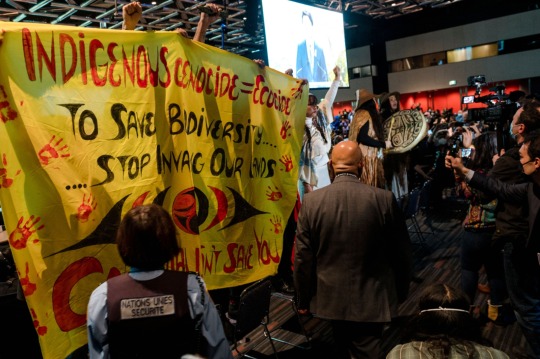
Part of that work is figuring out what land to protect. And although Indigenous negotiators and advocates did manage to get language that enshrines Indigenous rights into the final agreement, they are still concerned. Over a century of colonial conservation has shown that it only serves the powerful at the expense of Indigenous peoples.
“European countries are not going to evict white people from their lands,” said Longo. “That is for sure. This is where you see all the racism around this. Because they know how these targets will be applied in Africa and Asia. That’s what’s going on, they are evicting the people.”
Dinerstein, however, would argue that European countries have less natural resources to preserve, but more financial resources to help other countries.
“There’s a lot that can be done in Europe,” he said. “So we shouldn’t overlook that as well. I’m just making the point that there’s the opportunity to be able to do much more in other countries that have much less resources.”
Cooper said that in addition to implementation, monitoring and ensuring that rights are upheld will be a crucial task over the next seven years. “There will need to be a lot of work on monitoring. There’s always a justified nervousness that any global process cannot really see what’s happening at the local level and can end up with supporting measures that are perhaps not beneficial at the local level,” he said.
Although Indigenous leaders are going to keep fighting to ensure that the expansion of protected areas does not lead to continued violation of their rights, they are worried that the model itself is flawed. “It’s inevitable that the burden is going to fall again on developing countries,” Corpuz said.
#colonial violence#languages#How the world’s favorite conservation model was built on colonial violence#colonialism#brazil#indigenous populations#Yanomami#bolsanaro#the amazon#amazon rainforest#natural resources#ecology
27 notes
·
View notes
Text
still thinking about police violence against protesters in brazil. even before oct 7th 2023 I've seen students get literally arrested and beaten in public universities for standing up against zionist guest lectures and showing absolute support for Palestine. that never stopped them, no matter how militarized and violent our police is, bc they know it matters.
we can't let zionists be comfortable. the subsequent media storm and criticism against the university and the lecture got the protesters, even beaten and arrested, managed to get the message out there: facists are NOT welcome here and they never will be, even if the students have to fight against the institutions themselves.
so protest as much as you can. make sure the fascist zionists know they're not welcome, especially never without a fight. free palestine.
7 notes
·
View notes
Link
Won't back down
#Brazil#Lula da Silva#Gaza#genocide#denunciation#Israel#ethnic cleansing#Nazi Germany#holocaust#Hitler#war crimes#violence#colonialism#Palestine
4 notes
·
View notes
Text
Brazil: Inquiry in Police Killings Falls Short
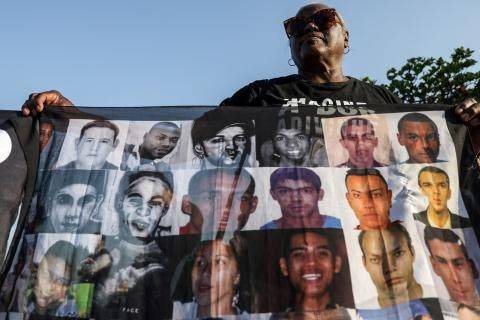
The initial steps taken by civil and ‘scientific’ police to investigate 28 killings during a July 2023 military police operation in Baixada Santista, in São Paulo state, Brazil, have been inadequate and did not comply with international standards, Human Rights Watch said in a report released today.
In the 19-page report, “‘They Promised to Kill 30’: Police Killings in Baixada Santista, São Paulo State, Brazil,” describes the important failures in the initial steps of police investigations. Law enforcement officers initiated the so-called Escudo (“shield”) operation in Baixada Santista, a metropolitan area on the coast of São Paulo state, on July 28, 2023, in response to the killing of an officer in the city of Guarujá. By September 5, when the operation ended, the military police had killed 28 people, making it one of the deadliest police operations in São Paulo state in 3 decades. Another three officers were also injured during the operation.
Brazil has long had a serious problem with excessive use of force by police. Police killed more than 6,400 people in 2022, according to the nonprofit Brazilian Forum of Public Security, which compiles the data from official sources at the state level. While some killings by police are in self defense, many result from excessive use of force, contributing to a cycle of violence that undermines public security and endangers the lives of civilians and police alike. Human Rights Watch has identified serious failures in civil police investigations into killings by police.
5 notes
·
View notes
Note
Hey Liv, when I saw that there was an attempted coup going on in your country, I immediately thought of you. How are you feeling? Are you physically safe? Do you have someone safe who you can talk to? Also, I hope you that your pain meds are keeping you comfortable.
Im safe, tho I'm very afraid not just for me but for the people I love and the state of brazilian democracy. Last I saw, over 400 people were jailed. There was a lot of destruction, not just in structure but in famous pieces of art. The police allegedly turned away from their posts and let them into the building, which is a symbol of democratic power in Brazil. They tried to pull the same shit people did in the US two years ago when Biden took power because Lula is usually a leftist. The local governor was temporarily removed from power in the early hours of the 9th of January because he is being accused of being complicit in letting people camp for months outside the military headquarters (they were begging the military to takeover), for not directing police fast enough to the area during the violence and for even escorting those "protesters" into the area they planned on destroying. And destroy they did. Thing is, a lot of politicians are complicit or involved because they are too from the far right and support a coup. It's important to remember that Bolsonaro left Brazil but is also being accused of creating the havoc. He is currently in the US probably trying to avoid more charges of corruption and an eventual arrest. It's also important to remember he was part of a mock trial that put Lula behind bars (the trial has been dismissed now) just so he could win the elections in the first place in 2018. It's absolutely scary.
Federal intervention was decreted after local government failed to bother to protect the area.
The meds aren't being enough to help with the pain while I sleep, because my body can't find a comfortable position. I'm exhausted. I slept for less than 3 hours. But for the most part, I am okay. It's scary out here tho. Last week was a lot.
I live where this happened but I'm luckily not too close to the area they attacked.
Thank you so much for your message! And for caring! It means a lot. 🥰🥹
28 notes
·
View notes
Text
I think the main difference I notice between the average USAmerica leftist and Brazilian leftist can be attributed to the fact that Brazil had a dictatorship, that was fought with tooth and nails to get rid of, and past that we got universal healthcare and voting rights again. I wish I could say all of Latin America is like this since so many of us had dictatorships but I don't know that many people from other countries (if you're latino please tell me), i think the average brazilian leftist understands there's no worth on peacefully resisting and if you want something, you need to fight or you'll be take and killed, or silenced, or "suicided". I note in a lot of (mainly white) USAmerican leftists that they wait for the change to be made for them instead of going like "wait, I can be a catalyst for changes" even if they're small.
#bernardo talks a lot#idk there's this difference specially on how they view the violence of the oppressed as equal to the violence of the oppressor which I want#to put under a microscope and stidy it in a lab setting#this sense that the world will change for the better alone#while on brazil we had baby steps constantly towards a better xountry#then that conservative ass came along and undid 30 years of work#with right propaganda imported straight from USA#most of the rightganda here is imported#even the queer infighting is imported#I've met the real actual queer community and they're a bunch of fags that couldn't care less about identity#and then i see Brazilian youth in the internet being fed this american right agenda thst there's a right way to be queer#and I BEG THEM TO PLEASE GO OUTSIDE#i think our conservatives were also way tamer before the imported rightganda#oh btw USA intervened here to make the dictatorship happen and then in 2016 (impeachment of an elected left president)#and then 2018 (election of a dictatoe wanabe that can't even talk coherently)
3 notes
·
View notes